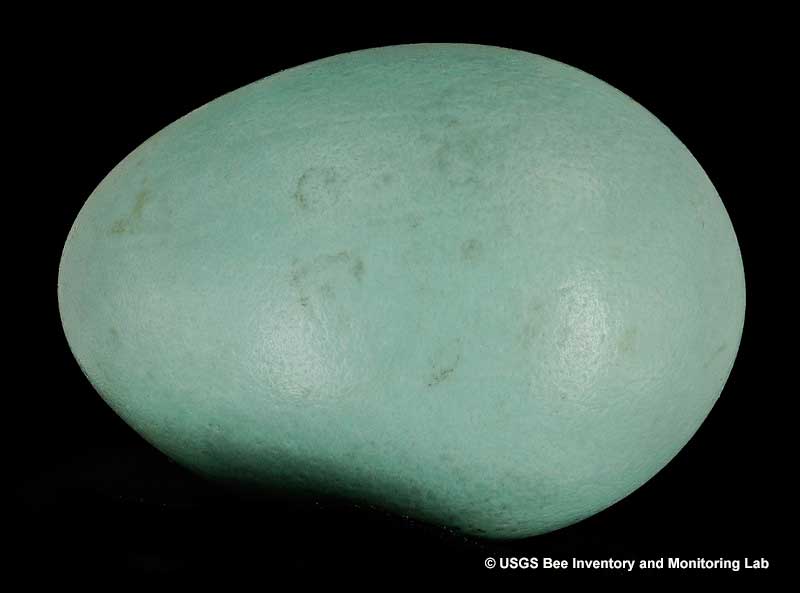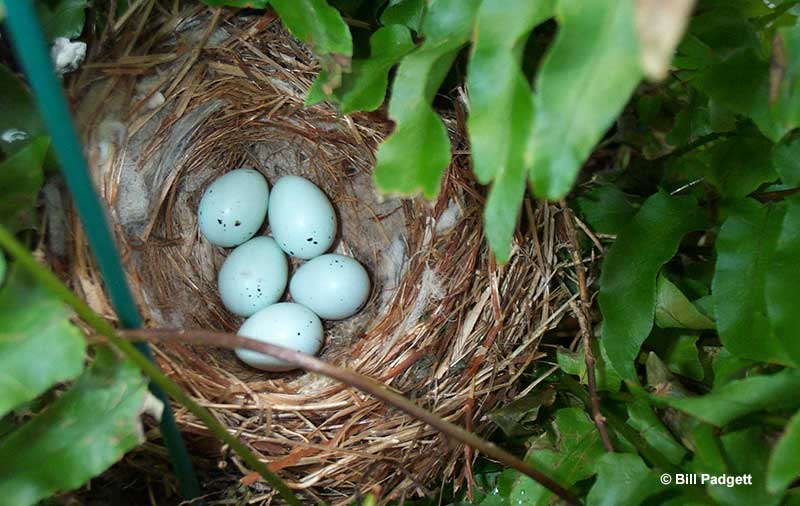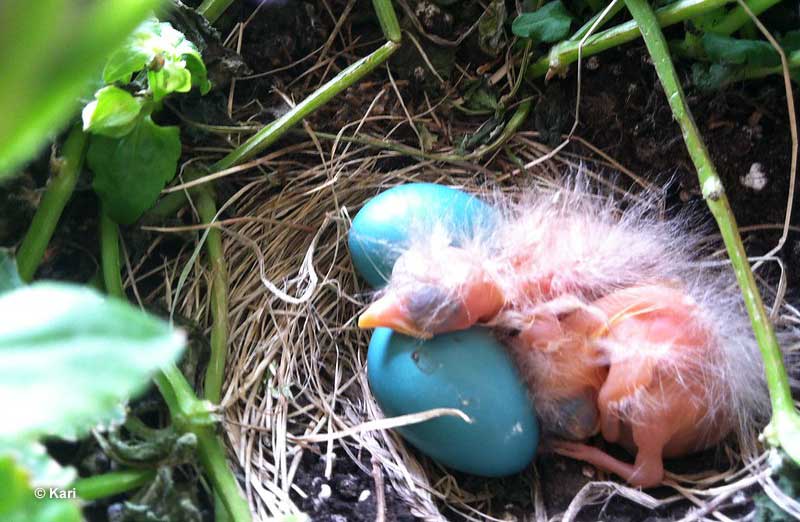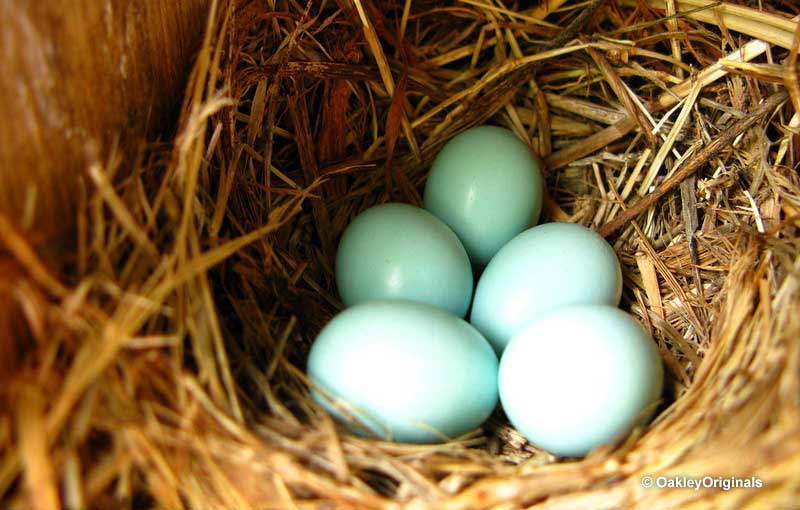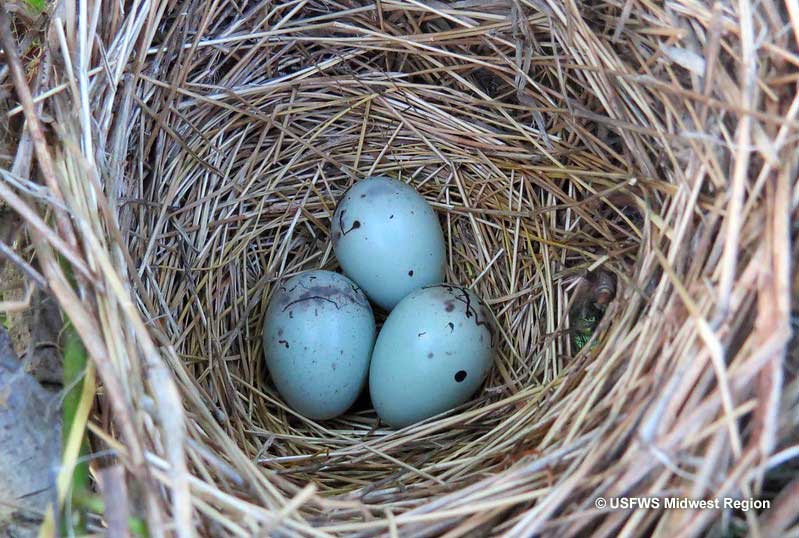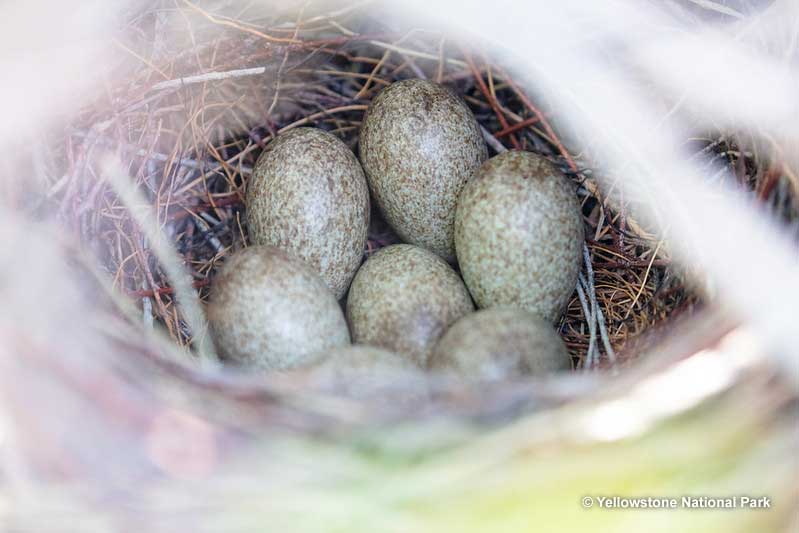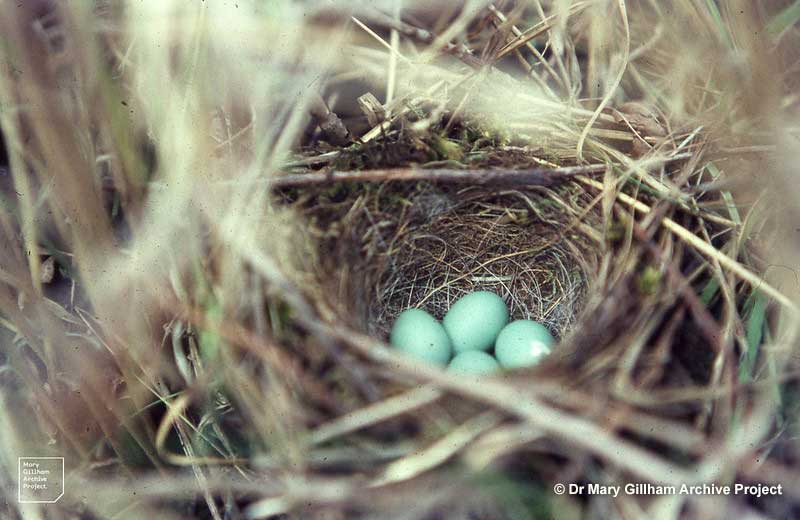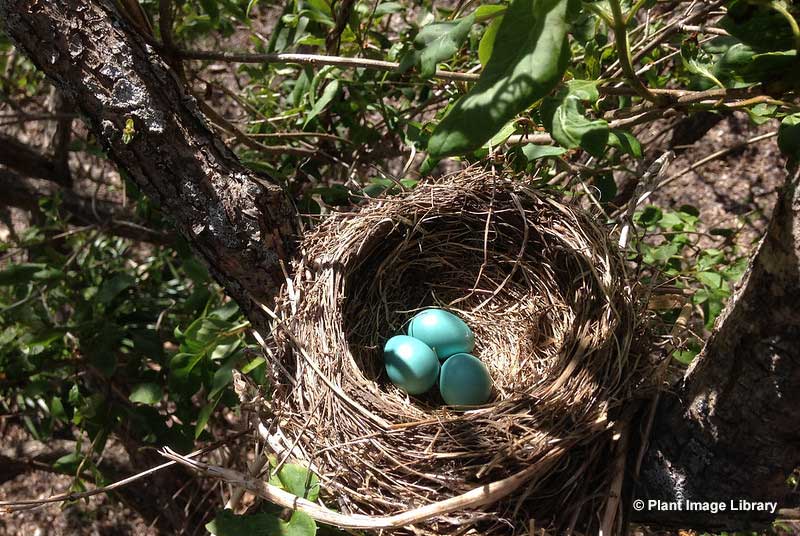
Bird eggs can show a wide array of colors and patterns. However, some of the prettiest bird eggs are blue!
Several bird species lay beautiful blue or blue-green eggs. Why don’t they just lay white eggs? What purpose do blue eggs serve? Which birds lay blue eggs the most? See this article for answers to these and other questions about blue bird eggs!
The Phenomenon of Blue Eggs
A good number of birds lay blue eggs. It would seem that any bird would be better off laying eggs with much better camouflage!
However, contrary to that train of thought, lots of birds from different avian families lay turquoise, pale blue, or even bright blue eggs.
Many of us have also found bits of blue eggs in our own backyard. Those colorful eggs could be evidence that American Robins nested in the yard.
The eggs of many bird species have speckled camouflage eggs, but there are a lot of blue eggs out there too. Female birds are able to make blue eggs with the use of special biliverdin molecules. These provide the eggs with blue colors, although certain foods probably also help birds generate blue pigments.
Although no one is quite sure exactly why birds lay blue eggs, there are a few possible explanations. One of the main reasons is to likely to protect the developing bird embryo from harmful UV rays. However, blue eggs might also confuse predators, or help birds recognize their eggs.
European Starling
European Starlings lay 4 to 6 pale blue eggs that can be plain or with a few small dark markings. These pretty little eggs are small and around 0.8 inches wide and 1.2 inches long. Some starling eggs can also be pale greenish or slightly darker blue, but most are the color of a pale winter sky.
Starlings are aggressive birds that nest in tree cavities, nest boxes, and similar situations. Both sexes incubate the eggs for 12 days. After they raise the first brood, they can nest again and have a second brood.
Blue Jay
Blue Jays lay 2 to 7 small blue eggs in an unkempt-looking stick nest. In general, their eggs are 0.8 inches wide and 1.2 inches long.
Just after laying, the eggs can be a pale greenish blue. However, shortly after, they usually lose their greenish color and can be bright blue or medium-blue. They are also frequently speckled with varying amounts of dark brown markings.
The female Blue Jay incubates her eggs for 17 to 18 days while the male brings her food and helps protect the nest from squirrels and other predators. These beautiful birds can raise one or two broods each nesting season.
House Finch
House Finches lay 2 to 6 small, pale blue-green eggs in a cup nest made of small sticks and other vegetation. Their eggs are 0.6 inches wide and 0.8 inches long. They are typically very pale blue with purple-brown speckles.
The amount of speckling on House Finch eggs varies, even in the same brood. They can be heavily speckled or only have a few markings on one end of the egg. The female incubates her eggs for around two weeks.
These industrious little birds usually nest low on a ledge or similar spot and can raise three broods in one nesting season!
American Robin
American Robins lay 3 to 5 beautiful, shiny blue eggs in a cup nest made of twigs, grass, other vegetation, and mud. These eggs are usually bright blue, but can also be greenish-blue or very pale blue with faint dark speckling.
They are 0.8 inches wide, 1.2 inches long, and incubated by the female for close to two weeks.
Keep reading: Robin nest & eggs
American Robins make their nests anywhere from close to the ground or high in a tree. They build their nests on a thick branch underneath dense foliage. These cheerful birds can also raise two to three birds each year.
Bluebirds
Bluebirds lay 4 to 5 sky blue eggs in a cup nest inside of a tree cavity or nest box. Their eggs are usually plain blue, but rarely, some nests also have a white egg or even a pale pink egg!
They are 0.8 inches wide and .9 inches long and are only incubated by the female for 13 to 20 days. Bluebird populations have greatly increased with the help of bluebird nest boxes. These nest boxes lack a perch, are placed in meadows and other open areas, and can help bluebirds raise three broods in a year.
Blackbirds
Blackbird species such as the Red-winged Blackbird lay 2 to 5 pale blue eggs with dark scribbled patterns on the middle and wider end of the egg. They can also be grayish or greenish-blue and are .8 inches wide and 1.1 inches long.
The female Red-winged Blackbird incubates her eggs for 11 to 13 days while her mate watches for predators. In spring and early summer, when I see a male giving a sharp alarm call, I know I’m near a nest! This species builds its nest in marsh vegetation and shrubby habitats, and can raise three broods in one nesting season.
Crows
Crows might lack colorful plumage, but they make up for it by laying beautiful eggs! American Crows lay 3 to 9 eggs that can be 1.2 inches wide and 1.2 inches long. Their eggs are usually dull pale blue or pale green-blue and have some dark speckling. This speckling can be faint or scattered all over the egg.
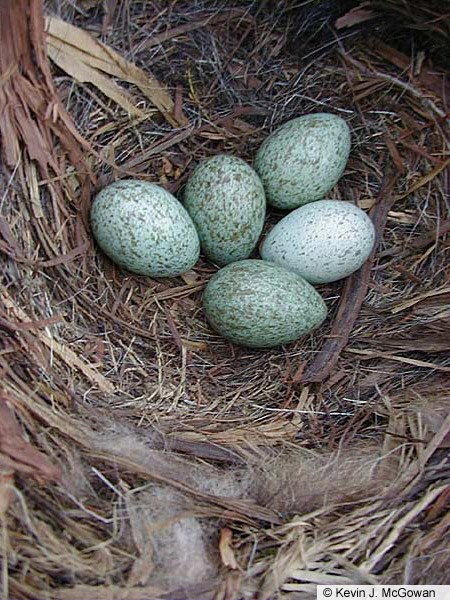
American crow nest and eggs
Female American Crows incubate their eggs for 16 to 18 days while her mate and other crows feed her and watch for predators. This species builds a big, bulky stick nest, usually high in a tree. They can also raise two broods per nesting season.
Wood Thrush
Wood Thrushes lay 3 to 4, turquoise-green eggs in a cup nest made of twigs, leaves, and other bits of vegetation. The eggs are one inch long, 0.75 inches wide, and are also usually quite shiny.
The female Wood Thrush incubates them for 11 to 13 days and does all the incubation on her own. She also does most of the nest building and constructs it on a sturdy fork or branch in a shrub or young tree. Wood Thrushes often raise two breeds each nesting season.
A speckled or different-looking egg in a Wood Thrush nest is probably a cowbird egg.
Grackles
Common Grackles lay 1 to 7 eggs that are 1.12 inches long and 0.83 inches wide.
Their eggs are also usually pale blue with some dark brown speckles and dark, squiggly lines. However, they can also be green-blue or even green-gray. This species lays its eggs in a bulky, rather messy nest made of twigs, sticks, and other bits of vegetation and even pieces of paper.
The Common Grackle female does all of the incubation, although males can help a bit with nest building. On average, she incubates her eggs for 13 days and typically only raises one brood.
Magpies
Eurasian Magpies lay 2 to 8 eggs that are 1.36 inches long and .94 inches wide. Their eggs are usually blue-green and covered with olive-brown speckling. Magpie species in North America lay similar eggs but the Black-billed Magpie’s eggs are much more gray or tan than blue-green.
However, the Yellow-billed Magpie of California lays eggs that can be pale greenish-blue with speckling. Magpies make large domed nests out of twigs, grass, and mud, and often construct them on utility poles or in trees. She does all the incubation duties until the eggs hatch 16 to 18 days later.
Gray Catbird
Gray Catbirds lay one to six eggs in a cup nest made of grass, twigs, strips of vegetation, and other plant matter. Their eggs are one inch long, 0.6 inches wide, and are a beautiful blue color. They can be bright sky blue, pale blue, or have a pretty, sea-green blue hue. Once in a while, they also have a few small reddish spots.
Female Gray Catbirds incubate their eggs, all on their own, for 12 to 13 days. However, during incubation, her mate brings her food and can help guard the nest.
This species makes its nest in shrubs, saplings, or vines, and can raise three broods per year.
Dunnock
The Dunnock is a small bird in the Accentor family and mostly lives in Europe. This neat little bird lays 3 to 6 sky-blue or pale blue eggs in a cup nest made of moss and twigs and lined with hair. Their eggs can also be pale blue-gray and are 0.74 inches long and 0.55 inches wide.
The female Dunnock incubates her eggs for 12 to 13 days and makes her nest low in a shrub or short tree. This species can also raise two to three broods per year and nests from March on to July.
Snowy Egret
Snowy Egrets lay 3 to 4 eggs that are 1.3 inches wide and 1.7 inches long. Their eggs are usually pale greenish-blue but can also sometimes be nearly white. This heron species lays its eggs in a big, bulky stick nest in a tree in a swamp or other spot over water. Like most heron species. it also nests in colonies.
The female Snowy Egret does most of the nest building but most sexes incubate the eggs for 24 to 25 days. They only raise one brood each nesting season. Both parents also help feed the young after they hatch.
Green Heron
Green Herons lay 2 to 6 eggs in a semi-open, shallow cup nest. Their eggs are 1.3 inches wide, 1.6 inches long, and are usually a pretty, pale, sky-blue color. Both parents help with incubation duties for 3 weeks.

Image credit: Jay Stout & Audubon
This small heron can nest alone or in colonies, and usually nests above or near water. Both sexes typically pick a shrub or tree with dense foliage that can help hide and protect the nest.
The male helps at first, but then the female does most of the nest construction. Green Herons can also raise two broods each nesting season.
Blue Grosbeak
The Blue Grosbeak lays 3 to 5 eggs that are usually 0.6 to 0.7 inches wide, and 0.8 to 0.9 inches long. They are very pale blue and before hatching, they often become paler to the point of being early white. Once in a rare while, a Blue Grosbeak egg can also have a few small red markings.
The female incubates her eggs for 11 to 12 days and is fed by her mate during that time. She lays her eggs in a rather loose cup nest made of grass, twigs, and leaves, and constructs it in a shrub or dense grass. Blue Grosbeaks can also raise two broods per year.


